Millions of people throughout the tropics consume wild meat. Overhunting reduces food security for people and large predators, yet little is known of the impact of hunting in systems where people and predators target the same prey species. We collate published data on predator diet in Belize with interview data about the consumption of wild and domestic meat by Belizeans, to compare the wild-meat diets of humans, jaguars Panthera onca and pumas Puma concolor and assess the sustainability of the combined offtake by humans and jaguars. Six wild mammal species (nine-banded armadillo Dasypus novemcinctus, paca Cuniculus paca, collared peccary Pecari tajacu, white-lipped peccary Tayassu pecari, red brocket deer Mazama americana and white-tailed deer Odocoileus virginianus) comprised 7% of the animal-protein meals eaten by Belizeans. Overall, 80% of these meals were eaten by 20% of interviewees, suggesting a necessary role of wild meat for the minority. The same species were found in 69 and 86% of jaguar and puma scats, respectively. We estimate a national annual harvest of c. 4,000 tonnes of these six wild mammals by humans and jaguars, of which 78% is hunted by people. Sustainability is difficult to evaluate because prey population data are lacking in Belize. However, simple models suggest that a sustainable harvest at this rate would require higher prey population densities than averages recorded in hunted Neotropical forests. We emphasize the need for robust regional estimates of game species densities, to improve assessments of sustainability and inform hunting regulations. We recommend that the requirements of predators as well as those of people be considered when assessing wild meat harvests.


